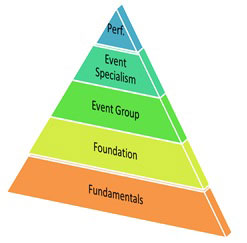

Developing Aerobic Capacity
Jamie French and Matt Long explore the concept of 'AEROBIC POWER.'
''Aerobic power" is synonymous with 'V02 max'. Understanding what these terms mean can lead to performance improvements, particularly in middle—and long-distance events. This article provides a brief overview of the physiological underpinnings of 'aerobic power' and outlines the kinds of activities that can improve aerobic capability within athletes.
Definition
American-based elite endurance coach Terence Mahon said recently, "In simple terms, V02 max is the size of your aerobic engine. The genetic component determines how large an engine you have, and the training component determines your ability to maximize that engine size". (BMC News, Autumn 2012). It refers to the maximum amount of oxygen a body can process at any moment. It is possible to narrow the definition to reflect how much oxygen one can use in one minute per kilogram of body weight to account for different body sizes.
Theory
The factors influencing maximal aerobic power (or VO2 max) can be divided into Utilization and Presentation Theories. The former concerns the efficiency of molecules in processing fuels and oxygen to produce the body's energy source, ATP. The latter concerns the efficiency of the heart, lung, and blood transport systems in transporting oxygen where it is needed.
Importance
The VO2 max/kg is essential based on physiological principles. As running intensity increases, there is a corresponding demand for oxygen consumption to continually produce energy. VO2 max is important because it is the critical factor in determining the point at which athletes start to produce energy using the time-limited Lactate Energy System.
Variations
Male athletes tend to have a higher V02 max than females, for example, the five-time world cross country champion and Seoul Olympic 5,000m champion John Ngugi, registered 85.0. The late great Norwegian Greta Waitz, who won nine New York City marathons and pocketed an inaugural world championship gold in Helsinki in 1983, registered 73.5. These variations are primarily due to anatomical differences, such as lung capacity. In addition to gender, as the maximum heart rate and stroke volume decrease with age, there is a corresponding reduction in VO2 max. Athletes below ten tend to show an underdeveloped aerobic system in terms of chronological age. However, after 12 years old, the VO2 Max/kg body mass is equivalent to that of adults, meaning that training needs to be different (Bar-Or and Rowland 2004)[2].
How to improve VO2 Max
Research has demonstrated that the VO2 max can be increased by exercising the heart rate to 65-85% of its maximum for at least 20 minutes. Ordinarily, the training effect would need a frequency between 3-5 sessions per week (Mackenzie, 2001)[3]. Caution should be exercised when prescribing too much progression or too little recovery between exposures/sessions, as this may lead to injury. Having mastered the 'Fundamentals' of agility, balance, and coordination for 'Foundation' level athletes (see diagram below). Constant pace running should be limited to 10 minutes, with training focusing on pace judgement for different periods. The duration of continuous pace running can be increased when athletes are deemed mature enough to move to the 'Event Group' and 'Event Specialist' phases of progression.

Long-Term Athlete Development Model
'Performance' athletes at the top of the above pyramid can continue to improve their aerobic power. Mahon cited the example of Athens Olympic marathon bronze medallist and 2006 London marathon winner Deena Kastor, who improved her V02 max from 70-80 ml/kg over a four-year period, which saw her training volume increase through progressive overload. So, the message is that aerobic power may have a genetic component, but it can be nurtured.
Article Reference
The information on this page is adapted from French & Long (2012)[1] with the author's kind permission and Athletics Weekly's permission.
References
- FRENCH, J. and LONG, M (2012). To the Max. Athletics Weekly, November 8th 2012, p. 52-53
- BAR-OR, O. and ROWLAND, T.W. (2004) Pediatric Exercise Medicine. Champaign, IL: Human Kinetics
- MACKENZIE, B. (2001) VO2 max [WWW] Available from: https://www.brianmac.co.uk/vo2max.htm [Accessed 12/10/2012]
Page Reference
If you quote information from this page in your work, then the reference for this page is:
- FRENCH, J, & LONG, M. (2012) Developing Aerobic Capacity [WWW]. Available from: https://www.brianmac.co.uk/articles/article132.htm [Accessed
About the Author
Jamie French and Dr Matt Long are British Athletics Coach Education Tutors. The former lectures sports science at Leeds Metropolitan University, and the latter is a volunteer endurance coach with Birmingham University AC.